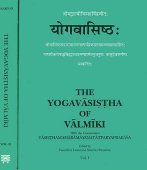Shaivagama, Śaivāgama, Shaiva-agama: 10 definitions
Introduction:
Shaivagama means something in Hinduism, Sanskrit. If you want to know the exact meaning, history, etymology or English translation of this term then check out the descriptions on this page. Add your comment or reference to a book if you want to contribute to this summary article.
Shaivagama has 9 English definitions available.
The Sanskrit term Śaivāgama can be transliterated into English as Saivagama or Shaivagama, using the IAST transliteration scheme (?).
Languages of India and abroad
Sanskrit dictionary
[Deutsch Wörterbuch]
Source: Cologne Digital Sanskrit Dictionaries: Böhtlingk and Roth Grosses Petersburger WörterbuchŚaivāgama (शैवागम):—(śaiva + ā) m. eine heilige Schrift der Śaiva [Weber’s Verzeichniss No. 941. 1025.] [Oxforder Handschriften 102,a,2. 249,a, Nalopākhyāna 4. 271,a,6.] [SARVADARŚANAS. 80,14. 88,19.]
Sanskrit, also spelled संस्कृतम् (saṃskṛtam), is an ancient language of India commonly seen as the grandmother of the Indo-European language family (even English!). Closely allied with Prakrit and Pali, Sanskrit is more exhaustive in both grammar and terms and has the most extensive collection of literature in the world, greatly surpassing its sister-languages Greek and Latin.
See also (Relevant definitions)
Partial matches: Shaiva, Agama.
Starts with: Shaivagamasarasamgraha, Shaivagamashaucadipika.
Ends with: Virashaivagama.
Full-text (+837): Agama, Shivagama, Vijayagama, Shivaprakasha, Shivajnanabodha, Kamikagama, Bimbagama, Prastara, Karanagama, Suprabhedagama, Analagama, Yogajagama, Nishvasagama, Diptagama, Vrishabhasthapana, Vimalagama, Arunul, Lokapalashtakadana, Nandikeshvara Kashika, Virashaivagama.
Relevant text
Search found 24 books and stories containing Shaivagama, Śaivāgama, Shaiva-agama, Śaiva-āgama, Saivagama, Saiva-agama; (plurals include: Shaivagamas, Śaivāgamas, agamas, āgamas, Saivagamas). You can also click to the full overview containing English textual excerpts. Below are direct links for the most relevant articles:
Kashyapa Shilpa-shastra (study) (by K. Vidyuta)
5.2. Classification of the Āgamas < [Chapter 1 - Introduction]
2. Kāśyapa Śilpaśāstra (Introduction) < [Chapter 2 - Author and his Works]
Conclusion < [Chapter 2 - Author and his Works]
Expiatory Rites in Keralite Tantra (by T. S. Syamkumar)
1.2. Expiatory Rites in Śaivāgamanibandhana < [Chapter 3 - Expiatory Rites in Kerala Tantric Ritual Manuals]
1.1. Expiatory Rites in Prayogamañjarī < [Chapter 3 - Expiatory Rites in Kerala Tantric Ritual Manuals]
The Shiva Purana (by J. L. Shastri)
Chapter 32 - The description of excellent practice < [Section 7.1 - Vāyavīya-saṃhitā (1)]
Chapter 29 - The analysis of Vāgartha (vāg-artha) < [Section 7.1 - Vāyavīya-saṃhitā (1)]
A History of Indian Philosophy Volume 5 (by Surendranath Dasgupta)
Part 1 - Introduction to the philosophy of Śrīkaṇṭha < [Chapter XXXVI - Philosophy of Śrīkaṇṭha]
Part 1 - The Literature and History of Southern Śaivism < [Chapter XXXIV - Literature of Southern Śaivism]
Part 4 - Śaiva Philosophy according to Bhoja and his commentators < [Chapter XXXVIII - Śaiva Philosophy in some of the Important texts]
Gitartha Samgraha (critical Study) (by Partha Sarathi Sil)
3. The Tradition of Commentaries on Bhagavadgītā in Kashmir < [Chapter 1 - A Brief Sketch of the Bhagavadgītā]
2. The text of the Gītārthasaṅgraha < [Chapter 2 - Abhinavagupta and the Gītārthasaṅgraha]
1. Abhinavagupta and his works < [Chapter 2 - Abhinavagupta and the Gītārthasaṅgraha]
Temples of Munnur (Historical Study) (by R. Muthuraman)
Arulala Perumal temple daily Pujas < [Chapter 6]
Related products

